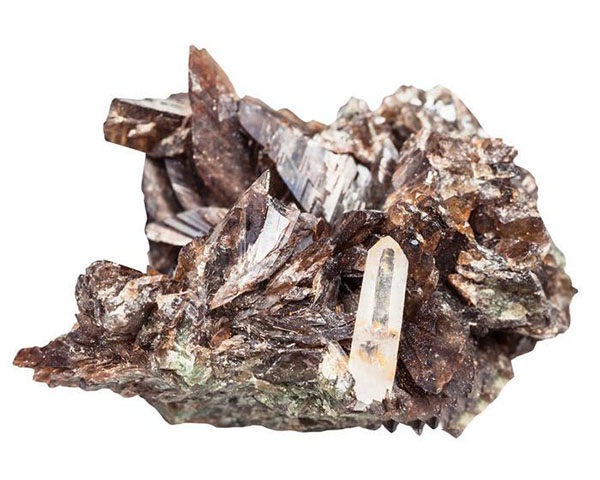The name Axinite comes from the Greek “axe,” which means cherry-shaped crystal, Axe-shaped or knife-edge shaped. Someone found magnesium containing Axinite with gem value In 1976.
Axinite is a complex boroaluminosilicate, which is the product of the interaction between molten igneous materials and the original limestone.
Axinite mainly occurs in the contact metasomatic metamorphic between granite and marble.
It belongs to the triclinic crystal system, Transparent to translucent, with glass luster. There are many colors, the most common color is maroon, and others are colorless, brown, purple, yellow and orange.
Axinite Gems have strong pleochroism. Gem-grade crystals are mainly produced in California, the United States, and the Alps of France. Other producing areas include Russia, Australia, Germany, Switzerland, Canada and Mexico.
Faceted gemstones are gorgeous and are mostly used for collection.

Basic properties of Axinite
Axinite is a kind of boroaluminosilicate mineral with complex composition. Its chemical formula is (Ca, Fe, Mn, Mg) 3Al2BSi4O15 (OH), and it often contains Mg, Na, K and other elements.
- Form: It belongs to the triclinic system. It is named because the crystal is often like an axe shape.
- Mohs hardness: 6~7.
- Cleavage: {100} cleavage is medium, {001}, {110} and {011) cleavage is incomplete.
- Density: 3.25 ~ 3.36 g/cm.
- Optical property: inhomogeneous body, biaxial crystal, negative optical property.
- Refractive index: 1.668~1.695, birefringence: 0.010~0.012.
- Gloss: glass luster.
- Color: yellow, blue, purple, brown, etc.
- Multicolor: strong. Generally, there is no fluorescence, and some individuals have red to orange-red fluorescence under ultraviolet light.
- Transparency: Transparent to translucent.
- 1Genesis and occurrence: It is often found in contact metasomatic rocks, pegmatites and aluminum-rich schists.
Chemical composition
Axinite is a kind of complex boroaluminosilicate mineral. The chemical formula is (Ca, Fe, Mn, Mg) 3Al2BSi4O15 (OH).
Generally, calcium accounts for about 2/3 of the number of cations. The manganese content is also high, and iron (FeO) is about 8%. Magnesium varies greatly.
Sometimes, there is a few percent of ferric iron (Fe2O3). In addition, potassium and sodium can be found.
Morphology
Axinite belongs to the triclinic system. Its symmetry is the lowest. The crystals are plate-shaped with sharp edges. It is also commonly found in pieces formed by the combination of sheets or plates;
Physical characteristics
Axinite usually ranges from brown to purple-brown (clove brown), brown yellow, purple-blue, purple, blue or colorless.
Glass luster, transparent to translucent. The biaxial crystal has negative optical properties, and the refractive index varies with the chemical composition.
The refractive index of most gem-grades Axinite is Np=1.678, Nm=1.685, Ng=1.688 (± 0.005), the birefringence is 0.010~0.012, and the dispersion is 0.014.
Strong Multicolor: α― Red to yellow, β― Purple red to purple blue, γ― Yellow to yellowish green.
Axinite is usually inert under long-wave ultraviolet light and short-wave ultraviolet light, but the lighter yellow Axinite emits red fluorescence under short-wave light; there are absorption bands at 466nm, 412nm,512nm and 492nm.
There is a group of apparent {010} cleavage; the fracture surface is shell-like or ladder-like, the Mohs hardness is 6.5~7, and the density is 3.29 (+0.007, -0.03) g/cm3.
How to identify Axinite
There are two-phase inclusions, mineral inclusions and color bands when magnifying observation.
Axinite is similar to the mineral topaz, Chrysoberyl and corundum. In terms of the refractive index, the refractive index of topaz is lower than that of Axinite, while the refractive index of Chrysoberyl and corundum is higher than that of Axinite.
The other two uncommon minerals, Kornerupine or enstatite, have the same refractive index and similar shape as Axinite. However, they can be distinguished according to their spectral properties and polychromatic.
Occurrence and origin
Axinite mainly occurs in the contact metasomatic metamorphic belt between granite and marble and also in the contact metamorphic belt of calcareous mudstone.
It is often associated with calcite, quartz, actinolite, etc. It can be carved into beautiful faceted gemstones, but it is easy to break, so it is mostly used for collection.
Axinite is mainly produced in the French Alps and Tasmania, Australia.
Axinite usually has a strong tricolor, and pleochroism colors can range from purple to pink, light yellow, and reddish brown.
The pleochroism colors of Axinite produced in Nevada of the United States are reddish brown, yellowish brown, yellowish green or colorless, while the pleochroism colors of Axinite produced in Sri Lanka are reddish brown, deep purple, colorless or grayish-yellow. There is usually no fluorescence under ultraviolet light. Yellow varieties can have red fluorescence under short-wave ultraviolet light.
Axinite produced in New Jersey has red fluorescence and long-wave property under short-wave ultraviolet light;
Axinite from Tanzania has dark red fluorescence under short-wave ultraviolet light and orange-red fluorescence under long-wave ultraviolet light.
In addition, it is also produced in Tasmania, England, Cornwall, near Yataihua, Canada, Tanzania (producing magnesium-containing Axinite ), Germany, Switzerland and other places.
Conclusion:
Axinite is mainly composed of calcium, iron, manganese and magnesium borosilicate minerals. Axinite is not exactly the name of mineral, but the name of mineral family. These minerals contain calcium, which can be divided into four categories according to the ratio of iron, manganese and magnesium contained.
Those with more iron are called “Ferroaxinite, “those with more manganese are called “Manganaxinite,” those with more magnesium are called “magnesium Axinite, “and those with more manganese and less calcium than Ferroaxinite are called “Tinzenite.”
When called Axinite alone, it usually refers toFerroaxinite or Manganaxinite. Axinite occurs in greenstone, skarn, metamorphic manganese mines and pegmatite, and its crystals are mostly plate-shaped like sharp Axe. Axinite with multicolor, high transparency and strong luster can be used as gemstones.
